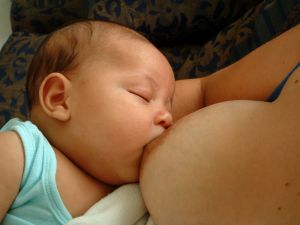Contents of breast milk changes over time. These changes naturally occur to provide your baby with the proper amounts of nutrients. Essentially, there are three types of breast milk.
- Colostrum is the first breast milk that will be produced after you give birth. This yellowish substance is produced within the first couple of days of your baby’s birth. Colostrum provides nutrients and antibodies that are crucial to a newborn baby. It also works as a laxative, for your baby, helping them to pass their first stool (meconium).
- Foremilk is the actual milk drawn, during feeding time – 3-4 days after child birth. This milk, like colostrum, is full of nutrients that your baby needs. Foremilk is a thin substance that is low in fat and natural for your baby to digest.
- Hindmilk follows the foremilk. This milk is much higher in fat content and calories. It is much creamier milk, which provides substance for your baby. Hindmilk is imperative to your baby’s health and continual growth.
Milk Flow
 Breast Milk
Breast Milk
The initial flow of milk may or may not come naturally. The natural feeding pattern of a baby actually helps breast milk to begin flowing. In the beginning, babies need to eat – breastfeed – frequently throughout the day. Depending on your baby’s size this may vary anywhere from 8 to 12 times a day.
Even though breast milk does not typically come in until the 3rd or 4th day, it is necessary to begin this natural feeding technique from day one. The natural sucking motion from your baby’s mouth encourages breast milk production.
Your breasts will start to feel full – also known as engorgement. Engorgement is when breast milk comes in, the switch from colostrum to foremilk. The only way to release the milk is through a breast pump or feeding. The sucking motion of your baby’s mouth stimulates what is known as “let down” reflex. Once this happens, your milk will begin flowing freely.
Benefits for Mum
Breast-feeding causes your uterus to contract, forcing it to shrink quickly. This is a great way to lose pregnancy weight, although should not be the only reason for breast-feeding. Say goodbye to baby flab quickly!
Breast-feeding is a natural birth control. It is not as effective as the pill or other birth control methods, but it does stop your body from ovulating. If your body is not ovulating, you are much less likely to get pregnant. It also lessens your overall chance of breast or ovarian cancer.
Breast-feeding is an economically smart approach to raising a baby. Even if you have to purchase bottles for pumped breast milk, you are not purchasing cases of formula on a weekly basis.
Benefits for Baby
The nutritional value that breast milk provides to babies is phenomenal! Breast milk is an immune booster as it contains numerous antibodies and health enzymes. These nutrients also help to prevent against allergies and eczema.
Babies that are breast-fed are much less prone to diarrhea and stomach upset. Babies digest breast milk much more naturally. It has also been proven to help prevent obesity, later in life.
The bond between mother and baby is unbreakable. However, this bond is much stronger when a child is breast-fed. You also no longer have to stress over the right temperature or amount as it is always perfect for your baby.
Breastfeeding Positions
There are many different ways to breast feed a baby. Below we will discuss four of the most common, comfortable breastfeeding positions
- Cradle position: Lay your baby on his or her side, facing your breast, while cradling him or her in your arms.
- Cross cradle: With this position, you will hold your baby in the same manner as the cradle position. However, one arm will support their back, with that hand on their head and your other hand on your breast.
- Clutch or football hold: Lay the baby under your arm with their head near your breast and their feet at your back. Wrap your arm around the baby so that your forearm is supporting their back and head.
- Side-lying position: Lie on either side and lay your baby next to you. Position your baby’s head right next to your breast for the perfect feeding position.
Breast Feeding for Working Mums
Working mums must first make preparations for pumping and storing milk for their baby. You will need a breast pump. There are two types of breast pumps, manual and electric. Manual (hand) pumps are cheaper and more portable, whereas electric pumps are more efficient. Pick a breast pump that you are most comfortable with.
- You will need to start by pumping your milk about a month before going back to work. This helps to get you in the habit of pumping.
- You will also need to find a caregiver that supports your desire to breastfeed your baby.
- Determine where you can privately pump your breast milk at work.
- Drink a lot of water and eat nutritional meals.
- Consult a lactation consultant if you feel at all stressed with the return to work.
You will need to store your milk at work and after you get home. Breast milk is good for about 4-6 hours after it has been pumped without being stored in a refrigerator or freezer. After this time, or before, it should be in a refrigerator. However, refrigerated milk is only good for 48 hours. Freezing breast milk is another option, and it can be stored for up to 2 months. Once thawed it should be used within 24 hours.
This article is part of Breastfeeding with Love campaign, initiated by The New Age Parents and New Age Pregnancy.
Join the Breastfeeding with Love Group to find out more and be part of our breastfeeding online community!
|
|
Click on the logos to find out more about our supporting partners.
* * * * *
Like what you see here? Get parenting tips and stories straight to your inbox! Join our mailing list here.
Want to be heard 👂 and seen 👀 by over 100,000 parents in Singapore? We can help! Leave your contact here and we’ll be in touch.
















































Leave a Comment: